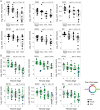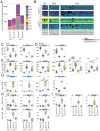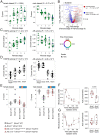Disruption of the circadian clock component BMAL1 elicits an endocrine adaption impacting on insulin sensitivity and liver disease
- PMID: 35238641
- PMCID: PMC8916004
- DOI: 10.1073/pnas.2200083119
Disruption of the circadian clock component BMAL1 elicits an endocrine adaption impacting on insulin sensitivity and liver disease
Abstract
SignificanceWhile increasing evidence associates the disruption of circadian rhythms with pathologic conditions, including obesity, type 2 diabetes, and nonalcoholic fatty liver diseases (NAFLD), the involved mechanisms are still poorly described. Here, we show that, in both humans and mice, the pathogenesis of NAFLD is associated with the disruption of the circadian clock combined with perturbations of the growth hormone and sex hormone pathways. However, while this condition protects mice from the development of fibrosis and insulin resistance, it correlates with increased fibrosis in humans. This suggests that the perturbation of the circadian clock and its associated disruption of the growth hormone and sex hormone pathways are critical for the pathogenesis of metabolic and liver diseases.
Keywords: circadian clock; estrogen; growth hormone; insulin resistance; nonalcoholic fatty liver disease.
Conflict of interest statement
Competing interest statement: C.J., B.D.W., E.M., F.A., C.G., A.C., D.M.-R., M.M., and F.G. are or were employees of Société des Produits Nestlé SA.
Figures






References
-
- Cedernaes J., Ramsey K. M., Bass J., “The role of circadian biology in health and disease” in Harrison’s Principles of Internal Medicine, 20E, Jameson J. L., et al., Eds. (McGraw-Hill Education, New York, NY, 2018).
-
- Speakman J. R., Evolutionary perspectives on the obesity epidemic: Adaptive, maladaptive, and neutral viewpoints. Annu. Rev. Nutr. 33, 289–317 (2013). - PubMed
-
- Hastings M. H., Maywood E. S., Brancaccio M., Generation of circadian rhythms in the suprachiasmatic nucleus. Nat. Rev. Neurosci. 19, 453–469 (2018). - PubMed
MeSH terms
Substances
LinkOut - more resources
Full Text Sources
Medical
Molecular Biology Databases

